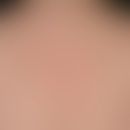Synonym(s)
HistoryThis section has been translated automatically.
DefinitionThis section has been translated automatically.
Schnitzler syndrome (SchS) is a rare, late-onset, non-hereditary (familial) autoinflammatory disease (AID), of which < 350 cases have been reported in the medical literature to date (de Koning HD 2014). According to the Strasbourg diagnostic criteria established in 2012 (see below), Schnitzler syndrome shows a chronic urticarial rash and a monoclonal gammopathy of the IgM and rarely IgG type (85%/15% of cases; mandatory main criteria/de Koning HD 2014). Minor Strasbourg criteria of the disease include recurrent fever, abnormal bone remodeling with or without bone pain, a neutrophilic infiltrate in the skin biopsy, and leukocytosis or elevated CRP.
The frequency of skin findings varies widely, with some patients having constant skin symptoms, while others have outbreaks only a few times a year. Individual skin lesions persist for 12-48 hours (de Koning 2014). Rashes and fever often occur simultaneously and can be triggered by stress, cold, heat, alcohol, spicy food and physical activity (de Koning et al.2014; Lipsker D 2010). In addition to the Strasbourg criteria, patients may present with arthralgia, myalgia, lymphadenopathy, weight loss, hepatosplenomegaly and angioedema (de Koning, 2014). The risk of developing a lymphoproliferative disorder, usually Waldenström's macroglobulinemia, within 10 years is around 13% (de Koning, 2014).
You might also be interested in
EtiopathogenesisThis section has been translated automatically.
Unexplained. Autoimmune etiology has not been conclusively clarified. It appears that IL-1 and the dysfunctional interleukin-1 receptor play a central role in the pathogenesis of the disease. Autoantibodies against IL-1 have been detected. It is possible that these AK prolong the biological half-life and thus the effect of this cytokine. This could explain the therapeutic effect of the interleukin-1 receptor antagonist anakinra.
ManifestationThis section has been translated automatically.
ClinicThis section has been translated automatically.
Significant feeling of illness with recurrent fever attacks (in about 90% of patients with temperatures < 40 °C), recurrent, itchy or painful, urticarial exanthema (neutrophilic urticarial dermatosis /NUD) (exanthema attacks accompany the periodic fever), fatigue and tiredness, arthralgias, arthritides and bone pain (esp.especially tibia and pelvic bones). Lymph node swelling and hepatosplenomegaly may also occur.
Neutrophilic urticarial dermatosis (NUD) is the characteristic skin finding of SchS and often precedes other signs and symptoms of the disease (de Koning, 2014). However, NUD is not specific to SchS, as it can also occur in other autoinflammatory syndromes such as CAPS and AOSD (adult-onset Still's syndrome), which must be excluded as differential diagnoses (Chen p. 2022). NUD is characterized by sometimes confluent, erythematous, annular or maculopapular lesions between 0.5 and 3 cm in diameter. Compared to chronic spontaneous urticaria, SchS lesions are less edematous. The rash is symmetrically distributed and affects the trunk and extremities, while the head and neck are rarely affected. The palms of the hands and soles of the feet are never affected. The frequency of exanthema varies considerably, ranging from daily to a few times per year, while individual skin lesions usually last 12-48 hours and heal without scarring (de Koning, 2014). Cutaneous involvement can be triggered by various factors such as stress, alcohol, hot spices, food, physical labor and exposure to hot or cold temperatures (Lipsker, 2010). However, a local cold test (ice cube test is negative Krause et al. 2012b). Only 21% of patients with SchS develop itchy skin lesions over time, with patients often reporting a burning sensation instead. Angioedema occurs in only 8% of patients with SchS (de Koning HD 2014).
LaboratoryThis section has been translated automatically.
HistologyThis section has been translated automatically.
DiagnosisThis section has been translated automatically.
At least 2 major criteria and 2 minor criteria (for IgM gammopathy) or three minor criteria (for IgG gammopathy) must be fulfilled for the diagnosis. In general, the urticarial rash is the first sign of the disease and precedes other signs and symptoms (median age at onset of rash = 51 years, median age at onset of fever = 52 years) (de Koning, 2014).
-
Main criteria:
- Chronic recurrent urticarial exanthema
- monoclonal IgM gammopathy (more rarely IgG gammopathy) of unclear significance ( MGUS).
-
Secondary criteria:
- Intermittent fever
- Arthralgia or arthritis of the large joints
- Bone pain
- Lymphadenopathy
- Hepato- or splenomegaly
- BSG/CRP elevations or leukocytosis
- Bone densification.
Differential diagnosisThis section has been translated automatically.
- Chronic urticaria (most important differential diagnosis): No fever attacks; also the broad symptoms of the Schnitzler syndrome are missing. No evidence of MGUS.
- Urticaria, autoreactive. Picture of chronic (not febrile), therapy-resistant urticaria. Frequently angioedema; usually increased anti-TPO-AAK and increased CRP.
- Adult breastfeeding syndrome: Similar clinical symptoms with recurrent febrile attacks, arthralgia and muscle pain. A gammopathy is absent. Skin lesions are of similar nature. Furthermore: Leukocytosis (> 10.000/μl) with > 80% neutrophilia, serositis, rheumatoid factor negative, ANA negative.
- CAPS = Cryopyrin-associated periodic syndrome: Very rare disease; clinical picture of cold-induced urticaria with mutant arthralgias. Long-term consequences due to the constantly elevated inflammatory parameters are systemic amyloidosis in some patients.
- Systemic lupus erythematosus (SLE): Urticarial or urticarial-papular febrile exanthema may also occur; however, laboratory and immunological symptoms (ANA, ENA; immunofluorescence) are conclusive.
- Lymphoproliferative diseases with paraproteinemia (see below paraproteinemia, skin changes).
- Fever syndromes, hereditary, periodic (very rare; corresponding family history; no gammopathies). S.a. Muckle-Wells syndrome; CINCA syndrome (chronic infantile neurological cutaneous and articular syndrome) and cryopyrin-associated periodic syndrome.
- POEMS syndrome (very rare): polyneuropathy, organomegaly, endocrinopathy, monoclonal gammopathy (myeloma detection!). Skin changes are described as hyperpigmentation, hypertrichosis, edema of the extremities and thickening of the skin; the picture is quite different.
TherapyThis section has been translated automatically.
Progression/forecastThis section has been translated automatically.
Note(s)This section has been translated automatically.
Case report(s)This section has been translated automatically.
- The 52-year-old patient had been observing recurrent urticarial skin changes on the entire integument for 10 years. The relapses, which persisted for about 4-6 weeks, initially occurred at intervals of several months. Over the years they have become more frequent. In the last year, however, she observed daily skin symptoms. She felt regularly "ill" like a flu with indisposition, exhaustion, indefinable myalgia and variable, quite painful joint complaints. The general practitioner had noticed a clearly increased BSG and a leucocytosis of 12.000-15.000 /µl. The previous therapy was carried out with intermittent glucocorticoids (which in medium doses helped promptly), temporarily in combination with azathioprine (100 mg/day p.o.).
- Findings: Considerable feeling of illness with temperatures between 39.5 and 40 °C. Dense trunk urticarial exanthema. Fatigue and tiredness, arthralgia, arthritis and bone pain. Sonographically proven splenomegaly and moderate lymphadenopathy. CRP is significantly elevated, high BSG, variable high leukocytosis (12-15,000 ul) with neutrophilia, thrombocytosis; detection of IgM-gammopathy (6.5 mg/l), no Bence-Jones proteinuria.
- Histology (non-specific): moderately dense vascular perivascular round cell infiltrate. Immunohistology: unspecific.
- Dg. Schnitzler syndrome.
- Therapy: Anakinra (100 mg/day s.c.). Including prompt improvement of clinical symptoms. However, discontinuation of the preparation led to a prompt recurrence. Under the now continued therapy with Anakinra the patient is free of symptoms for 10 months.
LiteratureThis section has been translated automatically.
- Berdy SS et al (1991) Schnitzler's syndrome: a broader clinical spectrum. J Allergy Clin Immunol 87: 849-854
- Chen S. (2022) et al.Rare mutations in NLRP3 and NLRP12 associated with familial cold autoinflammatory syndrome: two Chinese pedigrees.Clin Rheumatol 41: 3461-3470
- Cozzi A et al. (2016) Cutaneous manifestations of adult-onset Still's disease: a case report and review of literature. Clin Rheumatol 35: 1377-1382.
- de Koning HD (2014) Schnitzler's syndrome: lessons from 281 cases. Clin Transl Allergy 4: 41
- Elling E et al. (2008) Schnitzler's syndrome: chronic urticaria and monoclonal gammopathy-an autoinflammatory syndrome. JDDG 6: 626-631
- Janier M et al. (1989) Chronic urticaria and macroglobulinemia (Schnitzler`s syndrome): Report of two cases. J Am Acad Dermatol 20: 206-211
- Krause K. et al. (2012) How not to miss autoinflammatory diseases masquerading as urticaria. Allergy 67: 1465-1474
- Lipsker D (2010) The Schnitzler syndrome. Orphanet J Rare Dis 5: 38
- Masson Regnault M. et al. (2020) Cytokine signature in Schnitzler syndrome: proinflammatory cytokine production associated to th suppression. Front Immunol 11588322
- Niederhauser BD et al. (2014) Imaging findings in 22 cases of Schnitzler syndrome: characteristic para-articular osteosclerosis, and the "hot knees" sign differential diagnosis. Skeletal Radiol 43:905-915
- Pathak S. et al. (2019) Exploratory study of MYD88 L265P, rare NLRP3 variants, and clonal hematopoiesis prevalence in patients with Schnitzler syndrome. Arthritis Rheumatol. 71: 2121-2125
- Prendiville JS et al. (2004) A Pruritic Linear Urticarial Rash, Fever, and Systemic Inflammatory Disease in Five Adolescents: Adult-Onset Still Disease or Systemic Juvenile Idiopathic Arthritis sine Arthritis? Pediatr Dermatol 21: 580-588
- Rowczenio DM et al.(2018) Molecular genetic investigation, clinical features, and response to treatment in 21 patients with Schnitzler syndrome. Blood 131: 974-981
- Schnitzler L (1972) Lésions urticariennes chroniques permanentes (érythème pétaloïde?) Cas cliniques No 46 B. J Dermatol Angers, Abstract 46
- Seifert H, Großmann S (2008) Schnitzler syndrome. Act Dermatol 34: 135-136
- Symmank D et al. (2022) Dermatologic Manifestations of Noninflammasome-Mediated Autoinflammatory Diseases. JID Innov 3:100176.
- Treon SP et al. (2012) .MYD88 L265P somatic mutation in Waldenström's macroglobulinemia. N Engl J Med 367: 826-833
- Verret JL et al (1993) Schnitzler syndrome and Waldenström disease. Fatal outcome of the original case. Ann Dermatol Venerol 120: 459-460
- Willekens I et al. (2015) Correlative bone imaging ina case of Schnitzler's syndrome and brief review of the literature. Hell J Nucl Med 18:71-73
Incoming links (7)
Adult onset still disease; Anakinra; IL1R1 gene; Interleukin 1 receptor (type1); Muckle-wells syndrome; Neutrophilic urticarial dermatosis; Urticaria vasculitis;Outgoing links (19)
Adult onset still disease; Anakinra; Angioedema (overview); Antihistamines, systemic; Chronic infantile neurological cutaneous and articular syndrome; Cryopyrin-associated periodic syndrome; Fever syndromes, hereditary, periodic (overview); Interleukin 1 receptor (type1); Interleukins; Lupus erythematosus systemic; ... Show allDisclaimer
Please ask your physician for a reliable diagnosis. This website is only meant as a reference.







